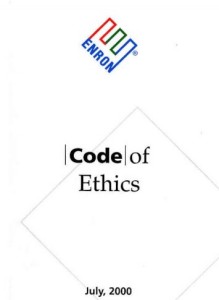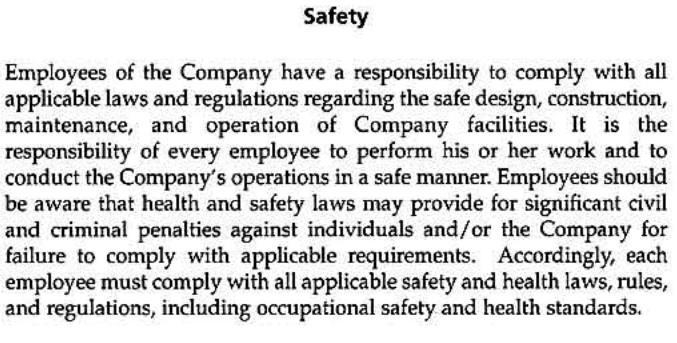Enron and the Hubris of the “World’s Leading Energy Company”
The Enron Saga
Though dwarfed by the 2008 global financial crisis, in January 2006 the trial was getting under way of the key executives behind the November 2001 bankruptcy of Houston based energy company, Enron.
Enron was originally a relatively pedestrian regional natural gas pipeline company, formed by the merger of Houston Natural Gas and InterNorth in 1985. It transformed itself into from an infrastructure operator to primarily an energy trading company, exploiting the deregulation of the energy sector.
Many were taken in. Enron was voted “America’s most innovative company” in Fortune magazine’s annual poll from 1996 to 2001, the year the company imploded. This was after it emerged that huge debts had been concealed, giving investors a false image of the company. As The Guardian notes:
Enron went from being a company claiming assets worth almost £62bn to declaring bankruptcy within a period of three months. Share prices collapsed from about $95 to $1.
The company used ‘mark-to-market accounting’ to hide their losses:
This is a technique used when trading securities where you measure the value of a security based on its current market value, instead of its book value. This can work well for securities, but it can be disastrous for other businesses.
The mark-to-market practice led to schemes that were designed to hide the losses and make the company appear to be more profitable than it really was.
Enron [used] off-balance-sheet special purpose vehicles (SPVs), also know as special purposes entities (SPEs) to hide mountains of debt and toxic assets from investors and creditors.
The SPVs involved dubious partnerships run by their own CFO. This was all signed off by accountants Arthur Anderson, who voluntarily surrendered its licenses to practice as Certified Public Accountants in the US in 2002 as the scandal developed.
Enron’s collapse led to new rules on the financial reporting. In July of 2002, President George W. Bush signed into law the Sarbanes-Oxley Act. The Act heightened the consequences for destroying, altering or fabricating financial records, and for trying to defraud shareholders.
Perhaps its therefore a surprise that Enron had an extensive Code of Ethics!
Enron’s Code of Ethics
Enron’s July 2000, 62 page Code of Ethics opens with with a letter from Enron founder and former Chairman Kenneth Lay, who assured employees that he conducts business “in accordance with all applicable laws and in a moral and honest manner.” Lay was convicted after the scandal but died before sentencing.
In the Code the company states:
We treat others as we would like to be treated ourselves. Ruthlessness, callousness and arrogance don’t belong here.
Bethany McLean, a reporter who identified before the collapse that all was not what it seemed at Enron, described Enron as having a ‘culture of arrogance’ and cited their large lobby banner ‘Enron: The world’s leading company’ (which replaced the ‘The world’s leading energy company’ slogan just prior to the collapse, almost as hyperbole had to be increased as the cover-up grew bigger). In one interview before the collapse with CEO Jeff Skilling:
Asked by the interviewer: “You’re the good guys?” Skilling responded: “We are the good guys… We are on the side of the angels.”
Skilling even suggested in a 1999 interview that the company could be managed ‘loosely” to foster innovation because of their ‘tight’ internal controls. The same article suggested Skilling was pressing employees to “find new ways to take advantage of the turmoil” unleashed by impending energy market deregulation. Enron is now known to have deliberately created real and imaginary power shortages during the 2000–2001 California energy crisis, in order drive up prices in the state’s newly deregulated energy market.
Enron said in their Code of Ethics:
We have an obligation to communicate. Here, we take the time to talk with one another and to listen. We believe that information is meant to move and that information moves people.
Yet the SPVs were an explicit example of hiding information to prevent investors ‘moving’ their investments i.e. dumping stock.
Shelfware
The Enron Code of Ethics smacks of classic ‘shelfware’: intended for outsiders than for actual implementation. Certainly poor leadership and contrary executive behaviour will have undermined the code, including the section (p60) on ‘reporting’ (one person did report the SPVs scheme, as per the Code to the Office of the Chairman, but only on the day in July 20001 when the CEO resigned, their claims were not fully investigated). McLean wrote:
Because Enron believed it was leading a revolution, it encouraged flouting the rules. There was constant gossip that this rule breaking extended to executives’ personal lives–rumors of sexual high jinks in the executive ranks ran rampant.
Many of these rumours proved to be true. The Economist even wrote in 2005:
It is only a slight exaggeration to say that office romance got a bad name, like so many things, from Enron, where loads of intra-office sex came with the territory for its masters of the universe.
Whereas the Code of Ethics said briefly:
Another section of the Enron Code of Ethics banned of company “officers, directors and employees” from trading in Enron shares despite the fact it was widespread.
Safety
The code, perhaps by its nature, emphasises individual’s legal compliance responsibility but often in a rather vague and general sense, as seen in the single paragraph on safety focused on “employees” (with no mention of “officers and directors”):
The text on IT passwords is longer! No reference is made to any specific Enron safety procedures or standards.
Three employees died in an explosion at their powerplant in Teeside, UK on 8 August 2001 after a transformer exploded. A few days later Ken Lay, after saying ‘”they still haven’t…figured out what caused it”, Lay then speculated it could have been due “human error” and an experienced employee “maybe not understanding a certain manual”
In that video Lay also admits that a fatality in India on a wind energy project had not been reported to senior executives for some time. But again he was confident in describing that as “human error” (even though errors are normally symptoms of deeper systemic or organisational issues not causes). He then emphasised that at Enron “Safety has to be number one” and “abiding by safety precautions” that “we preach all the time”.
Poor Leadership
Just weeks later a series of focus groups conducted by pollster Frank Luntz reported:
As is sometimes common, Enron expected all employees to sign a statement committing to abiding by the code. This approach is often a neat way to penalise low level employees in disciplinary cases but was certainly not applied in Enron against executive actions.
The code did make a prescient warning:
Many experts have concluded that if companies like Enron do not take active steps to adopt preventive policies and procedures covering securities trades by company personnel, the consequences could be severe.
Former Enron CEO Jeff Skilling (who resigned in July 2001) is scheduled for release on 21 February 2019 at the end of a 14 year sentence. He was fined $42 million.
We would however argue that ‘active steps’ need to be more than simply creating shelfware policies and procedures.
The punchline though is that Enron, for all its flaws and pathological behaviour never had the hubris to actually claim they were the “World’s Leading Energy Company”. As the Code of Ethics shows, that was simply their vision.
Which should make you think about companies that do make similar claims!
James Kerr, in Legacy: 15 Lessons in Leadership notes a Maori saying:
The kumara (sweet potato) does not need to say how sweet it is.
The spectacular implosion of Enron has been covered in many books (as well as countless theses, papers and articles):
- Anatomy of Greed (Cruver, 2002)
- What Went Wrong at Enron (Fusaro & Miller, 2002)
- Pipe Dreams (Bryce, 2002)
- Enron: The Rise and Fall (Fox, 2002)
- Power Failure: The Inside Story of the Collapse of Enron (Swartz & Watkins, 2003)
- Behaving Badly: Ethical Lessons from Enron (Collins, 2006)
- The Smartest Guys in the Room: The Amazing Rise and Scandalous Fall of Enron (McLean & Elkind, 2004) – our favourite and the excellent associated movie:
We have previously discussed corporate governance in: The Contrarian Director
UPDATE 1 March 2018: How Leaders and Their Teams Can Stop Executive Hubris: Building a culture of critical thinking and humility can spare companies from the ravages of excessive CEO confidence.
UPDATE 2 March 2018: Damning EY report reveals widespread cultural problems at Carillion
UPDATE 9 April 2018: Professor Dennis Tourish (Professor of Leadership and Organisation Studies at the University of Sussex) discussed The Dangers of Hubristic Leadership: Lessons from the Finance Sector at a British Army Centre for Army leadership annual conference in 2017. This included many horrific examples of hubris. He joked:
The banking sector has had a very bad press in the last number of years….That well-known Marxist magazine The Economist had a cover a couple of years ago called ‘Banksters’, published immediately after the LIBOR scandal, drawing attention to the dysfunctional leadership behaviours and the greed and avarice that was common within that sector.
When people in positions of authority acquire hubris it really does have a very serious, immediate organisational effect.
In the banking and finance sector people described to me the enormous institutional pressure for success. Huge rewards if you achieve success but success defined pretty much by narrow financial terms. ‘If we carry out this merger, this acquisition, or do these acts we will all get terribly rich’.
So you can see the incentive there to go in that particular direction: high levels of reward, which is always associated with the acquisition of power.
He concluded:
Ultimately leadership is 90 percent example and unless we, and people in authority, role model that acceptance of dissent other people will not take it seriously.
We need to lead with questions and not answers. We don’t have to pretend to have all the answers when we are in positions of authority. We need to use that magic phrase ‘I do not know.’ There are many historical examples that show the value of that kind of approach. I think we have drifted away from it. We need to go back to it.
UPDATE 17 June 2018: The Psychologist Guide to… Leadership Ten tips including 10. Be aware of your own power
Our every word, action, even a stern glance – incidental or otherwise – has greater consequence. Giant’s whispers are shouts, their outbursts are explosions. Being a leader means never forgetting this.
UPDATE 31 August 2018: Skilling is released from prison to a ‘halfway house’.
UPDATE 7 September 2018: The FT reports that companies formed by buying out Enron assets are doing rather well. Turns out not claiming to be world leaders but actually trying to be world leaders is a better strategy!
UPDATE 21 February 2019: Jeffrey Skilling released after 12 years in prison for role in Enron scandal





Recent Comments